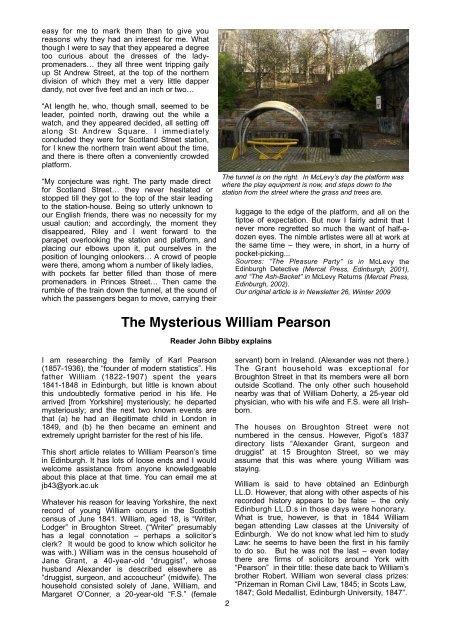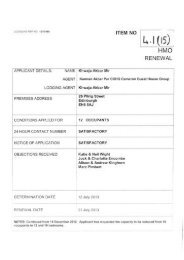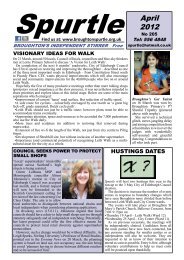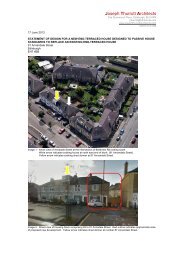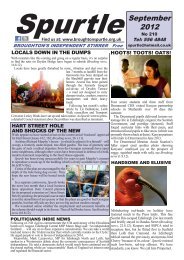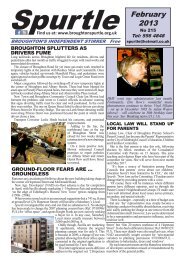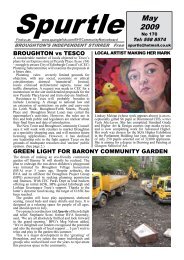BROUGHTON HISTORY SOCIETY NEWSLETTER - Broughton Spurtle
BROUGHTON HISTORY SOCIETY NEWSLETTER - Broughton Spurtle
BROUGHTON HISTORY SOCIETY NEWSLETTER - Broughton Spurtle
You also want an ePaper? Increase the reach of your titles
YUMPU automatically turns print PDFs into web optimized ePapers that Google loves.
easy for me to mark them than to give you<br />
reasons why they had an interest for me. What<br />
though I were to say that they appeared a degree<br />
too curious about the dresses of the ladypromenaders…<br />
they all three went tripping gaily<br />
up St Andrew Street, at the top of the northern<br />
division of which they met a very little dapper<br />
dandy, not over five feet and an inch or two…<br />
“At length he, who, though small, seemed to be<br />
leader, pointed north, drawing out the while a<br />
watch, and they appeared decided, all setting off<br />
along St Andrew Square. I immediately<br />
concluded they were for Scotland Street station,<br />
for I knew the northern train went about the time,<br />
and there is there often a conveniently crowded<br />
platform.<br />
“My conjecture was right. The party made direct<br />
for Scotland Street… they never hesitated or<br />
stopped till they got to the top of the stair leading<br />
to the station-house. Being so utterly unknown to<br />
our English friends, there was no necessity for my<br />
usual caution; and accordingly, the moment they<br />
disappeared, Riley and I went forward to the<br />
parapet overlooking the station and platform, and<br />
placing our elbows upon it, put ourselves in the<br />
position of lounging onlookers… A crowd of people<br />
were there, among whom a number of likely ladies,<br />
with pockets far better filled than those of mere<br />
promenaders in Princes Street… Then came the<br />
rumble of the train down the tunnel, at the sound of<br />
which the passengers began to move, carrying their<br />
The tunnel is on the right. In McLevy’s day the platform was<br />
where the play equipment is now, and steps down to the<br />
station from the street where the grass and trees are.<br />
luggage to the edge of the platform, and all on the<br />
tiptoe of expectation. But now I fairly admit that I<br />
never more regretted so much the want of half-adozen<br />
eyes. The nimble artistes were all at work at<br />
the same time – they were, in short, in a hurry of<br />
pocket-picking...<br />
Sources: “The Pleasure Party” is in McLevy the<br />
Edinburgh Detective (Mercat Press, Edinburgh, 2001),<br />
and “The Ash-Backet” in McLevy Returns (Mercat Press,<br />
Edinburgh, 2002).<br />
Our original article is in Newsletter 26, Wiinter 2009<br />
The Mysterious William Pearson<br />
! ! ! ! ! ! Reader John Bibby explains<br />
I am researching the family of Karl Pearson<br />
(1857-1936), the “founder of modern statistics”. His<br />
father William (1822-1907) spent the years<br />
1841-1848 in Edinburgh, but little is known about<br />
this undoubtedly formative period in his life. He<br />
arrived [from Yorkshire] mysteriously; he departed<br />
mysteriously; and the next two known events are<br />
that (a) he had an illegitimate child in London in<br />
1849, and (b) he then became an eminent and<br />
extremely upright barrister for the rest of his life.<br />
This short article relates to William Pearson’s time<br />
in Edinburgh. It has lots of loose ends and I would<br />
welcome assistance from anyone knowledgeable<br />
about this place at that time. You can email me at<br />
jb43@york.ac.uk<br />
Whatever his reason for leaving Yorkshire, the next<br />
record of young William occurs in the Scottish<br />
census of June 1841. William, aged 18, is “Writer,<br />
Lodger” in <strong>Broughton</strong> Street. (“Writer” presumably<br />
has a legal connotation – perhaps a solicitor’s<br />
clerk? It would be good to know which solicitor he<br />
was with.) William was in the census household of<br />
Jane Grant, a 40-year-old “druggist”, whose<br />
husband Alexander is described elsewhere as<br />
“druggist, surgeon, and accoucheur” (midwife). The<br />
household consisted solely of Jane, William, and<br />
Margaret O’Conner, a 20-year-old “F.S.” (female<br />
2<br />
servant) born in Ireland. (Alexander was not there.)<br />
The Grant household was exceptional for<br />
<strong>Broughton</strong> Street in that its members were all born<br />
outside Scotland. The only other such household<br />
nearby was that of William Doherty, a 25-year old<br />
physician, who with his wife and F.S. were all Irishborn.<br />
The houses on <strong>Broughton</strong> Street were not<br />
numbered in the census. However, Pigot’s 1837<br />
directory lists “Alexander Grant, surgeon and<br />
druggist” at 15 <strong>Broughton</strong> Street, so we may<br />
assume that this was where young William was<br />
staying.<br />
William is said to have obtained an Edinburgh<br />
LL.D. However, that along with other aspects of his<br />
recorded history appears to be false – the only<br />
Edinburgh LL.D.s in those days were honorary.<br />
What is true, however, is that in 1844 William<br />
began attending Law classes at the University of<br />
Edinburgh. We do not know what led him to study<br />
Law: he seems to have been the first in his family<br />
to do so. But he was not the last – even today<br />
there are firms of solicitors around York with<br />
“Pearson” in their title: these date back to William’s<br />
brother Robert. William won several class prizes:<br />
“Prizeman in Roman Civil Law, 1845; in Scots Law,<br />
1847; Gold Medallist, Edinburgh University, 1847”.


